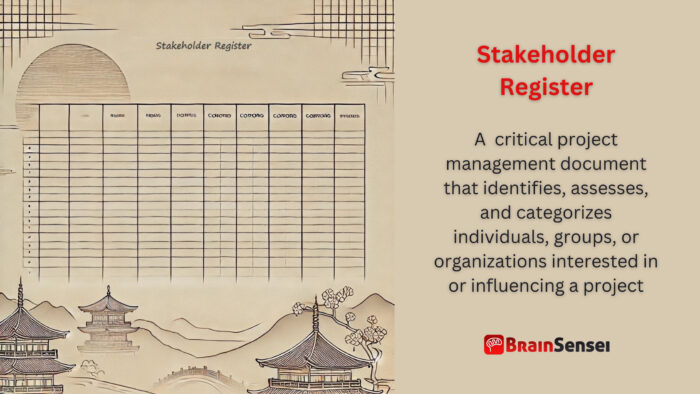
Stakeholder Register
What is a Stakeholder Register?
A stakeholder register is a critical project management document that identifies, assesses, and categorizes individuals, groups, or organizations interested in or influencing a project. It typically includes information such as stakeholder names, roles, interests, expectations, and levels of influence, enabling project managers to engage with stakeholders effectively.
Key Takeaways
- Provides a comprehensive record of all project stakeholders
- Helps identify stakeholder needs, expectations, and levels of influence
- Facilitates communication and engagement strategies
- Supports risk management by identifying potential sources of project disruption
- Ensures alignment between stakeholder expectations and project goals
Understanding the Stakeholder Register
How It Works
The stakeholder register is created during the project initiation phase and updated throughout the project lifecycle. The process involves:
- Identification: Listing all individuals, groups, or entities interested in the project
- Assessment: Analyzing stakeholders’ influence, impact, and expectations
- Classification: Categorizing stakeholders based on power, interest, and influence attributes
- Engagement Planning: Developing strategies to manage stakeholder relationships effectively
Important Considerations
- Stakeholder Dynamics: Stakeholder influence and interest may shift over time.
- Confidentiality: Manage sensitive information appropriately.
- Continuous Updates: Regular updates are crucial to ensure the relevance of the stakeholder register throughout the project lifecycle.
- Alignment with Communication Plan: The register must align with the project’s communication plan.
- Risk Identification: Identifying potential risks from stakeholder expectations or resistance.
Related Terms
- Stakeholder Analysis: The process of identifying stakeholder characteristics and potential impacts.
- Stakeholder Engagement Plan: A document outlining strategies for stakeholder communication and involvement.
- Project Communication Plan: A strategy for distributing project information to stakeholders.
- Project Charter: A document formally authorizes a project and identifies key stakeholders.
- Stakeholder Mapping: A visual representation of stakeholder relationships and influence.
Examples of Stakeholder Register Across Industries
Manufacturing Industry
A stakeholder register might include plant employees, suppliers, local government officials, and environmental regulators in a manufacturing plant expansion project. For instance, employees may have a high level of interest but low influence, whereas regulatory authorities may have a high impact due to permitting requirements. Regular updates help address concerns like operational disruptions and environmental compliance.
Expanding a manufacturing plant involves multiple phases, from initial design to construction and operational handover. The stakeholder register helps the project manager communicate clearly and address employee concerns about potential changes. The team monitors suppliers to avoid supply chain disruptions while regularly consulting with regulatory bodies to maintain compliance.
The register reveals concerns about potential noise and pollution from residents during the project execution phase. In response, the project team implements noise-reduction measures and effectively communicates these efforts. This proactive approach mitigates resistance and fosters community support.
Healthcare Industry
When implementing a new electronic health record (EHR) system, the register lists doctors, nurses, administrative staff, patients, and software vendors. The project manager assesses each stakeholder group for their influence on the system’s success and informational needs. The project team uses this register to prioritize training for high-impact users and address concerns about data privacy.
In one case, doctors expressed concerns about increased documentation time. Using insights from the register, the project team provided specialized training sessions and adjusted system configurations to simplify data entry. Nurses key system users, received early access to test the system and provide feedback. Educational materials explaining EHR’s benefits, such as improved care coordination, engaged patients.
Moreover, the register helps the team track compliance with health information privacy regulations. Software vendors ensure timely updates and technical support, preventing operational disruptions during system rollout.
Real Estate Development
A residential development project may involve investors, city planners, neighbourhood associations, and construction contractors. The register tracks their concerns, like project timeline adherence or community impact, and guides communication efforts to maintain trust and support.
For example, investors require regular financial updates to assess project viability. The project team uses the register to schedule monthly reports and meetings. The project team consults with city planners to ensure compliance with zoning regulations, while neighbourhood associations voice concerns about increased traffic. In response, the project team proposes infrastructure improvements and organizes community meetings to address these concerns.
The register highlights the need to engage with subcontractors during construction to ensure adherence to safety standards. The team also monitors potential environmental impacts, collaborating with environmental groups to implement sustainable practices. This inclusive approach, guided by the stakeholder register, fosters positive relationships and mitigates potential opposition, thereby underlining the crucial role of stakeholder management in project success.
These industry-specific examples demonstrate how a well-maintained stakeholder register enhances communication, mitigates risks, and supports project success across diverse sectors.
Use Cases of Stakeholder Register Worldwide
United States (Renewable Energy Project)
In a solar farm project in California, the stakeholder register helped identify and manage relationships with landowners, environmental groups, and utility companies. The project team developed strategies to address objections and expedite regulatory approvals by understanding stakeholder concerns about land use and ecological impact.
The project team identified landowners concerned about the impact on agricultural productivity. The team explained how the project would coexist with current land uses through meetings and site visits. Environmental groups raised concerns about wildlife displacement, prompting the team to collaborate with ecologists to design wildlife corridors.
Utility companies required clarity on grid connections. The register tracked communication and technical requirements, ensuring alignment with existing infrastructure. As the project progressed, new stakeholders, such as community advocacy groups, emerged. Continuous updates to the register facilitated ongoing engagement, helping the project achieve regulatory approval and community support.
France (High-Speed Rail Project)
In France, the project team coordinated a high-speed rail project using a stakeholder register with multiple entities, including transportation authorities, residents, and business owners. The register highlighted community opposition, prompting proactive engagement and adjustments to minimize disruption.
Residents near the proposed rail line voiced concerns about noise pollution. The project team used the stakeholder register to track complaints and propose mitigation measures like noise barriers. Business owners worried about disruptions during construction, so the team implemented a phased approach to minimize commercial impacts.
Coordination with government agencies required meticulous documentation. The stakeholder register tracked regulatory requirements, permit applications, and inspections. Community outreach events helped address misinformation and build trust. As the project neared completion, the register helped prioritize final-stage communications. The project team informed stakeholders about testing schedules and launch plans.
Singapore (Smart City Development)
A brilliant city initiative in Singapore involved diverse stakeholders such as government agencies, technology providers, and citizens. The register categorized stakeholders by interest and influence, enabling targeted communication and smoother project execution.
Government agencies required detailed updates on infrastructure integration. The register tracked inter-agency meetings and decision timelines. Technology providers needed access to technical specifications, prompting the project team to create a secure information-sharing portal.
Public engagement was crucial for the project’s success. The register identified community leaders and organized workshops to gather feedback on planned services. The team addressed concerns about data privacy through public forums and transparent policies. Over time, the register revealed growing interest from international investors, prompting the city to host a global innovation summit to showcase progress.
Best Practices for Using a Stakeholder Register
Using a stakeholder register effectively requires adherence to several best practices that promote comprehensive documentation, proactive communication, and strategic stakeholder engagement. Here are key strategies for maximizing the utility of this document:
Engage Early
Initiate the stakeholder identification process at the outset of the project. Early engagement allows for a thorough understanding of stakeholder expectations and concerns. For instance, in large infrastructure projects, delays often arise when the project team identifies key stakeholders late, leading to unforeseen objections.
Update Regularly
The stakeholder register should be a living document, revised periodically to reflect new information. Project phases often introduce new stakeholders or shift existing stakeholders’ influence and interests. Regular updates ensure the register remains relevant and actionable.
Prioritize Stakeholders
Apply tools like the power-interest matrix to prioritize stakeholder interactions. Understanding which stakeholders wield significant influence or are highly interested helps allocate resources effectively. For example, end-user groups with high operational impact in IT implementations should receive prioritized training.
Communicate Transparently
Transparent communication fosters trust and minimizes misinformation. The register should document communication preferences and key messages tailored to stakeholder groups. For instance, technical teams may prefer detailed reports, while executives favour high-level summaries.
Leverage Insights for Risk Management
Use the register to anticipate and mitigate risks. Stakeholders with high influence and negative sentiment can pose project threats. Early identification allows for proactive engagement strategies to address concerns and build alliances.
Integrate with Other Project Documents
Ensure the stakeholder register aligns with the communication plan, risk management plan, and project charter. Consistent documentation supports cohesive project execution and reduces the likelihood of oversight.
Promote Stakeholder Feedback
Actively seek and incorporate stakeholder feedback. Regular surveys, meetings, and workshops help validate register entries and uncover evolving concerns. In one transportation project, feedback sessions revealed community apprehensions about noise pollution, prompting timely mitigation efforts.
Train Project Teams
Educate team members on the purpose and utility of the stakeholder register. Clear guidelines on information gathering, entry updates, and confidentiality protocols ensure consistent and reliable documentation.
By implementing these best practices, project managers can enhance stakeholder engagement, improve communication efficacy, and mitigate potential risks, ultimately contributing to project success.
Common Mistakes and Issues
One common mistake is treating the stakeholder register as a static document. In a large infrastructure project, for example, failure to update the register led to missed engagement with a newly appointed regulatory authority, causing delays and increased costs. Continuous monitoring and updating can prevent such issues.
Another frequent issue is misclassifying stakeholders, which can lead to resource misallocation. For instance, a project team might underestimate the influence of a regulatory body, resulting in delayed approvals and costly project interruptions.
Another critical mistake is a lack of stakeholder engagement. When project teams fail to communicate effectively, stakeholders may feel disregarded, leading to diminished support and potential opposition. In a software implementation project, neglecting end-user input during the design phase can result in a system that does not meet operational needs.
Additionally, overloading the register with irrelevant details can reduce its usability. A concise, focused document that highlights key stakeholder attributes is more effective than one that attempts to record every minor interaction.
Lastly, ignoring cultural differences in global projects can lead to communication breakdowns. Cultural awareness and tailored engagement strategies are essential for maintaining positive stakeholder relationships across diverse regions.
Frequently Asked Questions (FAQs)
What information should a stakeholder register include?
A stakeholder register typically includes names, roles, contact information, influence level, expectations, and communication preferences.
Why is a stakeholder register important in project management?
It helps manage stakeholder relationships, ensuring their needs are understood and addressed, which supports project success.
How often should a stakeholder register be updated?
The project team should update it throughout the project lifecycle, particularly at major milestones or when significant stakeholder changes occur.
Who is responsible for maintaining the stakeholder register?
The project manager is usually responsible, though the project team and key stakeholders may provide additional input.
What tools can help create a stakeholder register?
Standard tools include spreadsheets, project management software, and stakeholder management applications.
Additional Resources
- 50 Quick and Easy Ways to Become Brilliant at Project Stakeholder Management
- Aligned: Stakeholder Management for Product Leaders
- Project Stakeholder Management
- Stakeholder Engagement Essentials You Always Wanted To Know
- Stakeholder Requirements: Managing and Resolving Conflicting Needs
Preparing for a PMI certification?
- Exam Prep Courses: PMP®, CAPM®, and PMI-ACP®
- Exam Simulators: PMP®, CAPM®, PMI-ACP®, PMI-PBA®, PMI-RMP®, PMI-SP®, PgMP®, and PfMP®
- Professional Development Units (PDUs): 15, 30, and 60 PDU Bundles



